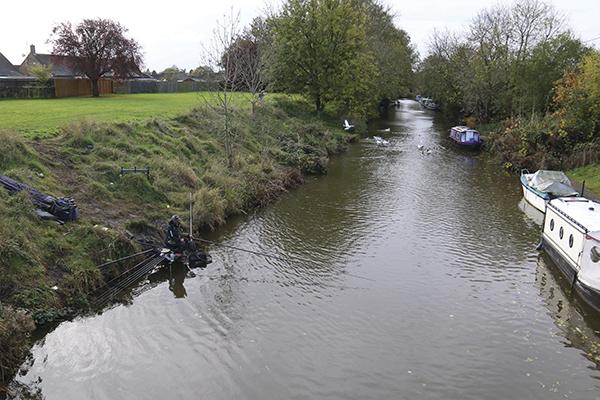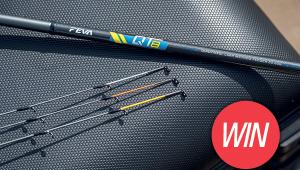Mark’s March Match Methods

The Old Nene at March might be a small, shallow venue, but it certainly holds fish! In early winter the weights are absolutely spectacular, but even as angling pressure builds it still produces reasonable weights. One angler who knows the water intimately and seems to be permanently on the list of framers there is Mark Pollard. We spent the day with him at the Wigstons Bridge area to see how he approaches the venue.
Packing A Punch
The first thing I noticed as I joined Mark was how quickly he set up! Yes, it was a steep muddy bank and he also had to set up in the water, but Mark already knew exactly what he was setting up. In fact, he gets out the same five rigs every match and only occasionally finds he needs to change any of them.
First out of the box is a 1g MP Roach rig. Mark sets this up on a top kit plus two sections. This puts him just into the deeper water and is the perfect distance on 99 per cent of pegs. It might be the only occasional wider peg or the presence of snags that will change this. At the moment Mark feels this line will almost certainly be for bread, but mentioned that if it was mild, groundbait and pinkies could be better. The colder the weather, the more likely he thinks bread will be best. The only other rig he sets up for this line is on a 3.5m whip. With five feet of water in front of him, the float pretty much settles perfectly over the 5m line. What is surprising is the lighter 0.75g rig on it. I naturally assumed that with the lesser control offered by the whip, Mark would use a heavier rig. He says: “The whip offers not just more speed but a completely different presentation. With the pole rig, I’m lowering the bait in, while with the whip I’m laying the rig out in front of me and letting it fall back towards me. This also picks off fish sat beyond the feed and I catch a lot of fish on the drop with the whip, so the lighter rig with slower fall helps with this.” Marks’s punch crumb mix was also interesting. As you would expect, he is using his own Polly’s Punch Crumb by Hinders. What makes this different is how coarse the particles are. This makes it very easy to mix as it doesn’t end up as a thick doughy mess, which finer mixes can. It also contains aniseed, which roach absolutely love and is a perfect complement to the bread. Although being easy to mix means he can get more water into it for weight, it still isn’t heavy enough for March when it is flowing, so a good handful of gravel is added to make sure it gets to the bottom. At the start, Mark feeds two big balls of this mix and aims to top up again every 20 minutes. “There are a lot of small fish in March and I’m convinced that if you’re catching the smaller fish on bread, it’s usually because you’ve not been positive enough with your rigs and feeding. “This line is always a good starting point as I like to fish March as I would a canal, by catching close before moving further over. If you’re on a load of fish, you could catch at five metres all day. The whip is also incredibly important as the different presentation will catch you extra fish, but it is also loads faster. Last year I caught over 500 fish on a 3.5m whip to win with 38lb!” A 4mm punch is his normal hook bait, although he will try a pinkie on the hook from time to time.
Going Over
Mark’s next line is for groundbait and is plumbed up just out of the deepest water, which is usually around 10 metres. Another reason he keeps his short line so close in is to make sure there is enough space between these two lines without them affecting each other. Again he sets up a reasonably heavy 0.5g olivette rig for this line, but also two lighter spread-shot rigs. The heavier of the two is a 7x10 MP1 and is set the same depth as the olivette rig, but the lighter 5x10 rig is plumbed up around a metre past his feed. This is to catch fish on the overspray from his catapult. The initial feed is three balls of Hinders Supercharged Natural Black, mixed with a small amount of brown crumb to add yet more feed content. After the venue has seen some hammer or it gets really cold, Mark will swap to the slightly finer Hinders Supercharged Canal Fine. He adds a few squatts and pinkies to the balls and looks to top up every 45 minutes or after the line has been disturbed by a boat. Flowing water means topping up more regularly, but this needs to be worked out on the day, as if the line doesn’t respond how he thinks it should he will stop feeding groundbait and rely on the loose feed alone. Choice of loose feed also depends on the clarity of the water. A clear river means squatts, while coloured water means pinkies. Rigs remain the same apart from dropping to smaller size 24 hooks for squatts. Although single and double squatt or pinkie on the hook are obvious hook baits, Mark will also try red maggots from time to time as a change bait can often bring another run of fish and is also a great bait for skimmers, should a few turn up. What was interesting was that even though it was flowing on the day, Mark still loose fed his pinkies right on top of his groundbait. “Those pinkies are definitely not landing on my groundbait, they must be ending up at least four metres down the peg. People think the fish eat the pinkies where they land but I’m sure they don’t. The groundbait is there to hold them and that is where they sit. Every time you loose feed, they come off bottom to grab a few before going back down again. “I’ll only try fishing down the peg where the pinkies the fish miss end up if it’s really hard. As long as you keep topping up with groundbait, they should stay over the main feed.”
Hemp
“Hemp is a bait that loses more matches than it wins, as most of the time they are the same fish as you catch on squatts and pinkies, just slower!” Mark laughs. “Whether the hemp is worth fishing or not is all about colour. If the river is coloured and the bigger fish have confidence to feed, it will work, especially if you have cover in your peg.” Again, Mark couldn’t give me a definitive depth that he fishes the hemp as it depends on water clarity, just that he fishes it in the shallower water and somewhere out of the way of his other lines. He feeds half a pot of hemp at the start spread over a bit of an area, then loose feeds over the top.
The Bypass
As you can see, Mark’s approach to March is very generic and simple. There is however, a part of the venue that really puts a spanner in the works! The bypass area is a little out of the town and is a little wider than in the town but he will fish the same rigs and same lines there. He was quick to warn that there are far more big fish on the bypass area, so chopped worms for perch and tench also come into play. The waggler can also work on the bypass, looking for big roach and rudd.
Our Day
Mark went straight out on bread and as expected, was straight into a fish every drop. The water was quite clear and running and by slowing the rig down slightly, he was catching every run through. The whip was okay and did catch a few fish, but generally the control of shortlining was best. To make sure he kept in touch with what was happening on his long line, he gave it a try every now and again to get a feel for how many fish were there and if the amount he was loose feeding and frequency of top-up balls was correct. A few boats came through and after each one Mark fed another ball of bread and went on to the pinkie line for a short while. This pattern worked well until one boat really revved up right over his feed, which not only killed his bread line but also pushed a load of snags over it. Every drop after that Mark came back with a twig or stick and ended up going on his pinkie line. “This just shows how important a two-line attack is. If I had only fed the one line and this had happened in a match, I’d have been stuffed!” Eventually, after continual feeding, Mark was able to catch down the middle again. After four hours, we call it a day with over 25lb of immaculate roach and ‘gustas’ in the net.
- Log in or register to post comments












